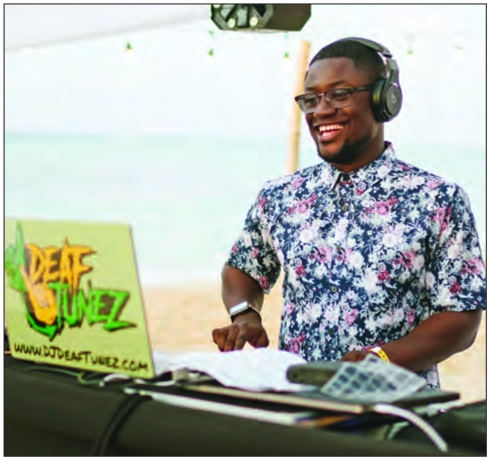
Visitors to the Museum of Science interact with the new, permanent hearing loss exhibit. 
Andre Robinson, also known as DJ Deaf Tunez, was inspired by two deaf DJs to pursue a music career.
Programming includes ASL Sundays and new hearing loss exhibit
During family gatherings, Andre Robinson used to observe as his cousin embodied the role of DJ, placing the needle on the records as he stood behind the tables. At about 3 years old, Robinson had begun losing his hearing, but the music at the get-togethers was always just loud enough for him to perceive it. He was captivated but unsure if he could pursue music, given his deafness.
Years later, when the Boston native went to New York, he was introduced to two deaf DJs: DJ Hear No Evil and DJ Nico. The two artists made Robinson’s dream feel within reach, so he began deejaying at college parties, invested in his own equipment and soon kicked off his career as DJ Deaf Tunez.
Using social media, he expanded his reach, promoting his work as both a deaf DJ and a comedian. His artistry attracted the attention of the Museum of Science, which reached out to Robinson to be a part of its Disability Pride Month programming. When he got the invitation, he could hardly believe it.
“It’s
a big deal to me, because the way I was brought up and raised here, in
the Boston area … it just never occurred to me that these opportunities
for this exposure [could happen] — the deaf community getting raised
up,” he said.
Robinson
is one of a handful of deaf and hard of hearing people who shared
stories about their experiences for the museum’s programming ahead of
and during Disability Pride Month.
This
year, the museum piloted its ASL Sundays program, held on one Sunday
each in May and June and the last one slated for July 14. The
programming, wherein the museum
offers American Sign Language interpretation for some of its shows, is
the brainchild of Sylvie Rosenkalt, the museum’s accessibility
coordinator, who wanted to create more programming for the disability
community and foster a sense of belonging.
“This year, I’ve been focusing a lot on the deaf
and hard of hearing community because we have this exhibit on hearing
loss opening,” Rosenkalt said. “And so we have this opportunity to
really do a meaningful collaboration with people with lived experience,
and go deeper into that community.”
The exhibit Rosenkalt referred to debuted in June
in the museum’s Hall of Human Life section, past the live animal
containers and a showcase on healthy eating. The permanent display walks
visitors through aspects of hearing loss in a series of four
interactive exercises detailing how it
occurs, the technologies used to manage it, how to communicate with deaf
and hard of hearing people, and hearing safety.
Steps away from the exhibit is a small theater where, at the click of a button, visitors can watch a
short, animated video centering on the experience of one of four deaf
or hard of hearing people. In one video, stylized in red, Jonathan Ozek
shares the story of the isolation he felt during a middle-school field
trip because of his hearing loss.
“It
was a message … that allows people to have a better understanding of
what’s it like to be deaf or hard of hearing,” Ozek said of the video.
“And so next time when people are interacting with somebody like me,
they were able to learn from that experience of coming here.”
For
the ASL and hearing-loss programming, Robinson — DJ Deaf Tunez — worked
with the museum’s digital team to produce a mini-documentary about his
life with hearing loss. The aim of the video, which will be released
ahead of this month’s ASL Sundays event, was to show that “deaf and hard
of hearing people are people,” he said.
Robinson
said he hopes the museum’s work will raise awareness about the need for
better accessibility, sign language interpreters, closed captioning and
ASL education.
“It’s a
great experience for people who are not deaf — hearing people — to
understand Deaf culture, Deaf community, to really know what the
struggles have been,” he said. “And to know what kind of access we need
in order to be able to achieve our goals, to be a part of the
community.”
ON THE WEB
Learn more at mos.org/events/asl-sundays